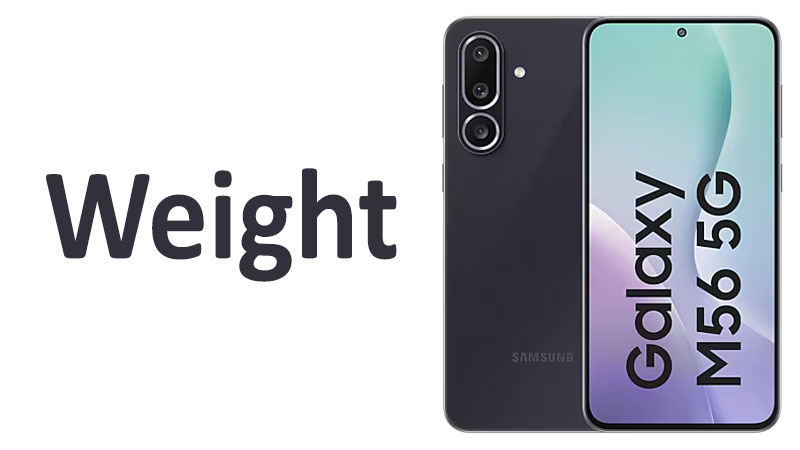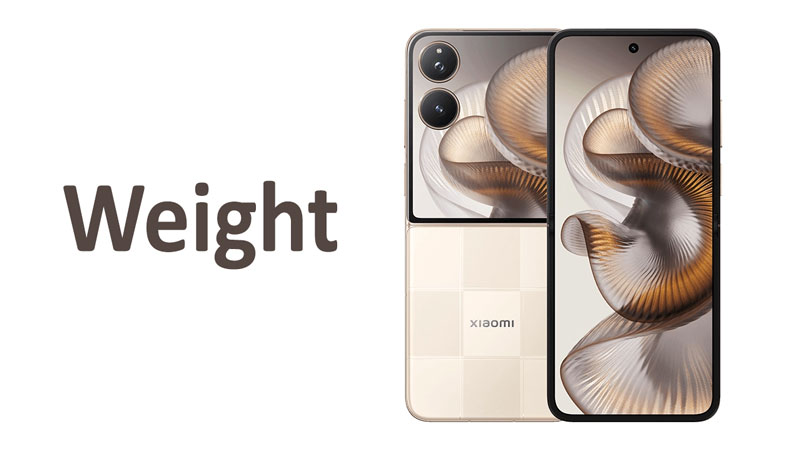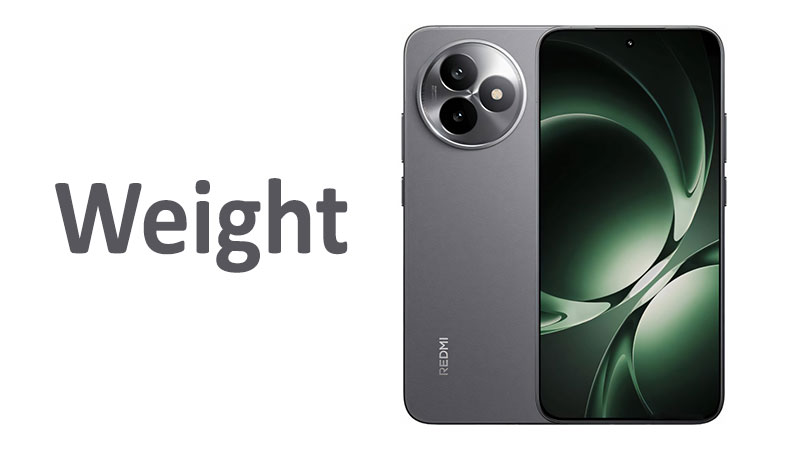The Samsung Galaxy M56 weight immediately signals a major shift in the company’s mid-range design philosophy. Modern smartphone buyers increasingly prioritize portability and comfort during long periods of use. The physical specifications of the Samsung Galaxy M56 make it a compelling choice in the highly competitive mid-range market.
This detailed article explores the exact weight measurements, analyzes the engineering behind this figure, and provides specialized comparisons against key competitors and its predecessor. Understanding the M56’s weight is essential for any consumer making an informed purchasing decision about this new-generation Galaxy device. We will examine how this lightweight profile impacts daily usability and overall buyer value.
Understanding the Samsung Galaxy M56 Weight Specifications
The precise weight of the Samsung Galaxy M56 is 180 grams. This specific measurement is significant, positioning the device firmly in the lightweight category for large-screened smartphones. In the Imperial system, this converts to approximately 6.35 ounces. For comparison, the average large-screen smartphone often sits between 195g and 220g.
Grams vs. Ounces: A Closer Look
Smartphone weight is universally measured in grams (g) across the global electronics industry. This metric offers greater precision than ounces (oz). The figure of 180g is a clear indicator of the device’s construction focus. While 6.35 ounces might seem abstract, 180 grams provides a tangible number that allows for direct comparison with specifications listed by other manufacturers globally. A smaller gram number directly correlates with a more comfortable and less fatiguing user experience. This precision matters when optimizing the device for pocketability and one-handed use.
The Importance of Physical Specifications
Weight is intrinsically linked to the phone’s dimensions and overall engineering. The Samsung Galaxy M56 boasts a remarkably slim profile, measuring 162.0 x 77.3 x 7.2 mm. The 7.2mm thickness is particularly noteworthy. Most phones housing a sizable battery are thicker, often surpassing 8mm. The M56’s lightweight nature and slim chassis suggest optimized internal component layout and careful material selection. This meticulous engineering contributes to the premium feel and improved ergonomics that consumers expect from a contemporary Samsung Galaxy device.
The Context of Lightweight Design
A key challenge for smartphone manufacturers is balancing crucial battery capacity with a thin, light form factor. The Samsung Galaxy M56 manages to achieve a very low weight while retaining a significant 5000mAh battery. This balance highlights major advancements in battery density and internal component miniaturization. The successful minimization of the M56’s overall mass, despite a large 6.74-inch display, is a primary selling point for the device.
Achieving the 7.2mm Thickness
The thinness of the Galaxy M56 directly supports its low 180g weight. The M56 is one of the slimmest Samsung mid-range phones in its class. To achieve this 7.2mm measurement, Samsung likely utilized advanced internal stacking methods and minimized air gaps between components. The slim profile not only makes the phone visually sleeker but also enhances the feeling of lightness in the hand. The reduced thickness is a crucial engineering feat when coupled with the 5000mAh power cell.
Materials and Build Quality
The choice of materials is the dominant factor determining the final weight of any smartphone. The Samsung Galaxy M56 uses a combination of materials optimized for strength and reduced mass. The official build specifications indicate the phone features a glass front and a glass back, protected by Corning Gorilla Glass Victus+. It uses a plastic frame. This hybrid construction is a common strategy in the mid-range segment. Using a plastic frame, often made of polycarbonate, dramatically reduces weight compared to an aluminum or stainless steel frame. This material choice is key to keeping the total weight at 180 grams, even with the protective glass layers on the front and back of the device. The careful balance maintains a premium glass feel without the excessive heft of an all-metal construction.
Specialized Comparisons: M56 vs. Its Peers
To fully appreciate the significance of the 180g weight, we must compare the Samsung Galaxy M56 with its immediate predecessors, its A-series rivals, and leading competitors in the wider Android ecosystem. The number 180g tells a story of strategic design decisions that affect competitive positioning and consumer appeal.
M56 vs. Galaxy M54: The 19-Gram Leap
The most important comparison is against the Samsung Galaxy M54, the previous model in the M-series lineup. The Galaxy M54 weighed 199 grams, despite also featuring a large display and a similarly sized battery. The Samsung Galaxy M56 achieves a massive 19-gram reduction in weight. This is a significant decrease in one generation. The M56 is almost 10% lighter than its predecessor. This reduction is instantly noticeable to users accustomed to carrying the M54. This lighter feel makes a substantial difference during long calls, extended gaming sessions, or prolonged social media scrolling. This weight loss comes without sacrificing the essential 5000mAh battery capacity, reinforcing the efficiency of the M56’s internal design.
M56 vs. A-Series Rivals
Samsung’s A-series devices are the M-series’ closest internal competitors. Looking at devices like the Galaxy A36 and the Galaxy A56 reveals a clear weight advantage for the M56. The Galaxy A36 weighs around 195 grams, and the Galaxy A56 weighs approximately 198 grams. Both A-series phones are substantially heavier than the M56. The Galaxy M56’s 180g weight makes it the superior choice for buyers who prioritize a minimal pocket footprint and comfort. This distinction is a major competitive edge for the M56 within Samsung’s own mid-range portfolio.
M56 vs. Flagship Lite and S-Series
Comparing the M56 to premium and semi-premium models provides further context. Flagship phones like the Samsung Galaxy S25 aim for ultimate portability, weighing around 162 grams. While the M56 is heavier than the true flagship, it sits comfortably below devices like the Galaxy S24 FE, which is often much heavier, sometimes exceeding 210 grams. The Galaxy M56 effectively occupies a sweet spot, providing a large screen and massive battery life in a package that approaches the weight of a true compact flagship. It balances power and portability better than many premium alternatives.
Comparison with Key Competitors
The 180g weight is highly competitive against other market rivals in the mid-range segment. Many competing phones from brands like Motorola, iQOO, and Xiaomi often hover near the 200-gram mark, particularly when they include large batteries (5000mAh or more). The Motorola Edge 60 Pro, a direct competitor, is slightly heavier at around 186 grams. The iQOO Neo 10R typically weighs in at 196 grams. The M56’s light body allows it to stand out immediately on a specifications sheet. This weight difference is often enough to sway a buyer who frequently carries their phone in a pocket or uses it constantly throughout the day. The lower weight translates directly to better overall handling and reduced wrist strain.
Pros and Cons of the 180g Weight
Every design decision involves trade-offs. The extremely low weight of the Samsung Galaxy M56 brings substantial benefits, but it also carries potential drawbacks that buyers should consider before purchase.
Advantages for the Everyday User
The primary benefit of the 180g weight is the noticeable improvement in daily user comfort. The Galaxy M56 feels significantly less burdensome in the hand and pocket than heavier, bulkier devices. This factor is crucial for users who spend many hours texting, browsing, or gaming. A lighter phone reduces fatigue and makes extended use sessions much more enjoyable. The light weight also enhances the phone’s overall portability. It slips easily into a tight pocket or small bag without creating a noticeable drag or bulge. For active users, such as those who listen to music while running or hiking, the M56’s weight is a major plus. The thinness and lightness make the phone easier to grip securely, reducing the chance of accidental drops.
Potential Trade-offs and Considerations
While lightness is generally a positive trait, some consumers associate physical heft with premium build quality and durability. The Samsung Galaxy M56 achieves its 180g weight partly by utilizing a plastic frame. A metal frame, while heavier, often offers superior rigidity and impact resistance. Therefore, the perception of durability might be lower for some buyers. Furthermore, the lightweight construction means the M56 is more sensitive to the weight added by protective cases and accessories. A heavy-duty protective case can easily push the total package weight close to 220 grams, negating the original benefit. Buyers must carefully select a slim, lightweight case if they wish to maintain the phone’s exceptional portability. The materials used, though covered by robust glass, still need careful handling.
Key Considerations for Samsung Galaxy M56 Buyers
Potential Samsung Galaxy M56 buyers should view the 180g weight not as an isolated specification, but as part of a holistic design package. This design makes the M56 uniquely positioned in the market.
The weight profile makes the M56 an ideal choice for specific user demographics. It is perfect for professionals who carry their phone all day, for students who value portability, and for users who consume a large amount of media on their phone. Buyers who prioritize an ultra-long battery life, but dislike the bulky feel that usually accompanies a large power cell, will find the M56’s 5000mAh battery combined with the 180g weight an exceptional combination.
Buyers should also note that the 7.2mm thickness, which contributes to the lightness, means the phone lacks a 3.5mm headphone jack. This is a common consequence of ultra-slim design choices. Consumers who rely heavily on wired headphones will need to use a USB-C adapter or switch to wireless earbuds. Additionally, while the phone is light, its large 6.74-inch screen still dictates a large physical size. Buyers with very small hands should manage expectations regarding one-handed reachability, even with the reduced weight. The screen size means the phone is tall and wide, regardless of how light it is.
The M56’s lightness also highlights the efficiency of the Exynos 1480 processor and 50MP camera system. High-performance components often require bulky cooling systems, but the M56’s slim design suggests that its internal thermal management is highly efficient and space-saving. This ensures that the phone remains lightweight without sacrificing performance capabilities. Overall, the 180g weight underscores the M56’s identity as a power-efficient, comfortable, and portable mid-range champion.
Conclusion
The Samsung Galaxy M56 weight of 180 grams (6.35 ounces) is arguably one of its most compelling and competitive features. This figure represents a successful engineering effort to deliver a large-screen, large-battery smartphone without the typical bulk. It marks a significant improvement over the heavier predecessor, the Galaxy M54. This lighter construction enhances long-term comfort, improves pocketability, and distinguishes the M56 from many competing mid-range devices that sacrifice ergonomics for battery capacity. For consumers seeking an exceptional blend of battery stamina and day-to-day portability, the Galaxy M56’s 180-gram design makes it an industry standout and a highly recommended option.
Frequently Asked Questions (FAQ)
What is the exact weight of the Samsung Galaxy M56?
The Samsung Galaxy M56 weighs 180 grams, which translates to approximately 6.35 ounces.
How does the M56 battery size affect its 180g weight?
The Samsung Galaxy M56 achieves its 180g weight despite housing a large 5000mAh battery, indicating advanced battery density and efficient, lightweight construction materials.
Is the Samsung Galaxy M56 considered a heavy or light phone?
At 180g, the Samsung Galaxy M56 is considered a light phone, especially given its large 6.74-inch display size. Most comparable devices weigh closer to 200g.
Did the Galaxy M56 get lighter compared to the M54?
Yes, the Samsung Galaxy M56 is significantly lighter than its predecessor, the Galaxy M54, which weighed 199 grams. This represents a 19-gram weight reduction.
Does the lightweight M56 support fast charging?
Yes, the Samsung Galaxy M56 supports fast charging at 45W, providing quick recharges for its 5000mAh battery despite the phone’s slim and light design.



